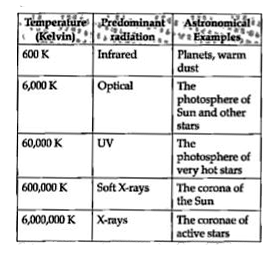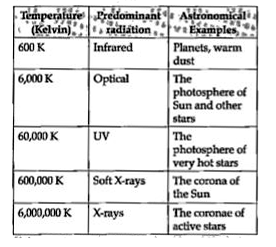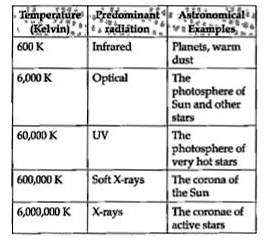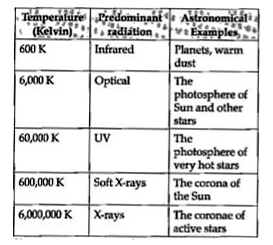When the light emitted by a distant galaxy is spectrographically analysed, it is found to contain the characteristic patterns of radiation emitted by famoliar elements, but their wavelength show a red shift of 2%. How fast is the galaxy receding away from us? Using Hubble's law estimate the distance of galaxy in light year.
Take Hubble's constant H=17kms−1 for every million light year.
The correct Answer is:0.02c or 6000kms−, 353 million light years
Step by step video, text & image solution for When the light emitted by a distant galaxy is spectrographically analysed, it is found to contain the characteristic patterns of radiation emitted by famoliar elements, but their wavelength show a red shift of 2%. How fast is the galaxy receding away from us? Using Hubble's law estimate the distance of galaxy in light year. Take Hubble's constant H=17kms^(-1) for every million light year. by Physics experts to help you in doubts & scoring excellent marks in Class 12 exams.
Similar Questions
When the light coming form a galaxy in the constellation Ursa Major was spectro graphically anaylised, it was found to contain a line in the calcium absorption spectrum at a wavelenth of 4170Å, the wavelength of same line as observed on the earth is 3970Å. Is the galacy receidng away from us? What is the velocity of recession?
View SolutionConsider a galaxy moving away from us with a speed of 6480kms−1. It is a at a distance of 430 million light year from us, determine Hubble's constant H and corresponding age of universe t0
View Solution
Knowledge Check
- Question 1 - Select One
The spectra of all stars show a continuous spectrum like the solar spectrum, in which dark absorption lines are superimposed. The photosphere (inner layer of the star) emits radiations of all wavelengths, producing a continuous spectrum. On passing through the outer (comparatively cooler) layer of the star, radiations of certain wavelengths are selectively absorbed by this layer. This is the cause behind the dark lines in the star's spectrum. These dark lines are characteristics of the substances present in the outer layer of the star. For measuring the surface temperature of the star, we need to measure the wavelength at which the intensity of emitted radiation is maximum and then using Wien's displacement law, given below
λm=T=b where b is the Wien's constant and its experimentally determined value is 2.89×10−3mK
Which of the following options is true for spectrum of light received from a star?AContinuous emission spectrumBabsorption line spectrumCemission line spectrumDemission band spectrum - Question 2 - Select One
Read the following text and answer the following questions on the basis of the same:
Spectrum Analysis and Astronomy
Each element in the periodic table can appear in gaseous form and produce its own spectrum unique to that element. Hydrogen will not look like Helium, which wil not look like carbon which will not look like iron....and soon. Astrophysists can identify what kinds of materials are present in stars from the analysis of star's spectra. This type of study is called astronomical spectroscopy. The science of spectroscopy is quite sophisticated. From spectrum lines analysis astrophysists can determine not only the element, but the temperature and density of that element in the star. The spectral line also can tell us about any magnetic field of the star. The width of the line can tell us how fast the material is moving. We can learn about winds in stars from this. The shifting of spectral liens shift back and forth indicates that the star may be orbiting another star. The following table shows a rough guide for the relationship between the temperature of a star and the electromagnetic spectrum.

If the spectrum of a star is red or blue shifted, then it can be used to infer its velocity along the line of sight. Edwin Hubble observed that more distant galaxies tended to have more red shifted spectra. This establishes the theory of expansion of the universe.
What may be the approximate temperature if soft X-rays are found predominantly in the spectrum?A60000CB600000CC60000KD600000K - Question 3 - Select One
Read the following text and answer the following questions on the basis of the same:
Spectrum Analysis and Astronomy
Each element in the periodic table can appear in gaseous form and produce its own spectrum unique to that element. Hydrogen will not look like Helium, which wil not look like carbon which will not look like iron....and soon. Astrophysists can identify what kinds of materials are present in stars from the analysis of star's spectra. This type of study is called astronomical spectroscopy. The science of spectroscopy is quite sophisticated. From spectrum lines analysis astrophysists can determine not only the element, but the temperature and density of that element in the star. The spectral line also can tell us about any magnetic field of the star. The width of the line can tell us how fast the material is moving. We can learn about winds in stars from this. The shifting of spectral liens shift back and forth indicates that the star may be orbiting another star. The following table shows a rough guide for the relationship between the temperature of a star and the electromagnetic spectrum.

If the spectrum of a star is red or blue shifted, then it can be used to infer its velocity along the line of sight. Edwin Hubble observed that more distant galaxies tended to have more red shifted spectra. This establishes the theory of expansion of the universe.
From the spectrum analysis the following information of a star can be obtainedAElements present, temperatureBMagnetic field, density, massCdistance of the starDBoth A and B
When a surface is irradiated with light of wavelength 4950Å, a photocurrent appears which vanishes if a retarding potential appears which vanishes if a retarding potential greater than 1.2 volt is applied across the phototube. When a different source of light is used, it is found that the critical retarding potential is changed to 2.1 volt. Find the work function of the emitting surface and the wavelength of second source. If the photoelectrons (after emission from the surface) are subjected to a magnetic field of 10 tesla, what changes will be observed in the above two retarding potentials. Use h=6.6×10−34Js,e=1.6×10−19C.
View SolutionRead the following text and answer the following questions on the basis of the same:
Spectrum Analysis and Astronomy
Each element in the periodic table can appear in gaseous form and produce its own spectrum unique to that element. Hydrogen will not look like Helium, which will not look like carbon which will not look like iron....and soon. Astrophysists can identify what kinds of materials are present in stars from the analysis of star's spectra. This type of study is called astronomical spectroscopy. The science of spectroscopy is quite sophisticated. From spectrum lines analysis astrophysists can determine not only the element, but the temperature and density of that element in the star. The spectral line also can tell us about any magnetic field of the star. The width of the line can tell us how fast the material is moving. We can learn about winds in stars from this. The shifting of spectral liens shift back and forth indicates that the star may be orbiting another star. The following table shows a rough guide for the relationship between the temperature of a star and the electromagnetic spectrum.

If the spectrum of a star is red or blue shifted, then it can be used to infer its velocity along the line of sight. Edwin Hubble observed that more distant galaxies tended to have more red shifted spectra. This establishes the theory of expansion of the universe.
What is astronomical spectroscopy?View SolutionRead the following text and answer the following questions on the basis of the same:
Spectrum Analysis and Astronomy
Each element in the periodic table can appear in gaseous form and produce its own spectrum unique to that element. Hydrogen will not look like Helium, which will not look like carbon which will not look like iron....and soon. Astrophysists can identify what kinds of materials are present in stars from the analysis of star's spectra. This type of study is called astronomical spectroscopy. The science of spectroscopy is quite sophisticated. From spectrum lines analysis astrophysists can determine not only the element, but the temperature and density of that element in the star. The spectral line also can tell us about any magnetic field of the star. The width of the line can tell us how fast the material is moving. We can learn about winds in stars from this. The shifting of spectral liens shift back and forth indicates that the star may be orbiting another star. The following table shows a rough guide for the relationship between the temperature of a star and the electromagnetic spectrum.

If the spectrum of a star is red or blue shifted, then it can be used to infer its velocity along the line of sight. Edwin Hubble observed that more distant galaxies tended to have more red shifted spectra. This establishes the theory of expansion of the universe.
Which nature of spectrum establishes the theory of the expanding universe?View SolutionRead the following text and answer the following questions on the basis of the same:
Spectrum Analysis and Astronomy
Each element in the periodic table can appear in gaseous form and produce its own spectrum unique to that element. Hydrogen will not look like Helium, which will not look like carbon which will not look like iron....and soon. Astrophysists can identify what kinds of materials are present in stars from the analysis of star's spectra. This type of study is called astronomical spectroscopy. The science of spectroscopy is quite sophisticated. From spectrum lines analysis astrophysists can determine not only the element, but the temperature and density of that element in the star. The spectral line also can tell us about any magnetic field of the star. The width of the line can tell us how fast the material is moving. We can learn about winds in stars from this. The shifting of spectral liens shift back and forth indicates that the star may be orbiting another star. The following table shows a rough guide for the relationship between the temperature of a star and the electromagnetic spectrum.

If the spectrum of a star is red or blue shifted, then it can be used to infer its velocity along the line of sight. Edwin Hubble observed that more distant galaxies tended to have more red shifted spectra. This establishes the theory of expansion of the universe.
The lines in a star's spectrum is found to shift back and forth. What conclusion may be drawn from this observation?View SolutionSupernova refer to the explosion of a massive star. The material in the central case of such a star continues to collapse under its own gravitational pull. If mass of the core is less is than 1.4 times the mass of sun, its collapse finally results in a white dwarf star. However, if the core has a mass greater than this, it could end up soon as a neutron. star and if its mass is more than about three solar masses, the collapse may still continue till the star becomes a very small object with an extremely high value of density called a 'Black hole'. Escape speed for a black hole is very large. The figure shows a block hole of radius R and another concentric sphere of radius RS, called the 'Schwarzschild Radius'. It is the critical radius at which escape speed equals the speed of light c. Nothing even the light, can escape from within the sphere of Radius RS. So light from a black hole can not escape and hence the terminology 'black hole'. There has been astronomical evidence of a small and massive object at the centre of our galaxy the 'Milky way'. Suppose that there is a particle at a distance about 6 light years. that orbits this massive object with an orbital speed of about 2×105m/s. Use the given data whereever necessary and answer the questions that hollow. G=6.67×10−11N−m2/kg2, Solar mass M=2×1030kg,C=3×108m/s,1 light year =9.5×1015m.

Theories suggest that it is not possible for a single star to have a mass of more than 50 masses. The massive object at the centre of milky way galaxy is most likely to be a :View Solution
